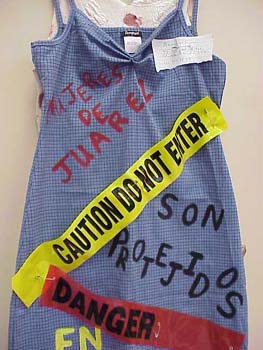
A Week of Special Events at ASU West
Some Personal Observations and Reflections on the Juarez Murders
Exhibits and Events
Barry M. Linder SBS 450

The Field of Victims
It was a very windy day and I was walking on the lawn in front of the library gazing at an awesome sight. What appeared to be a couple of hundred swaying slim pink crosses, as if waiting for a mass crucifixion, hypnotized me. The next day the crosses all bore brightly colored, hand-made and painted dresses. I walked among them for a while and recorded only a few of my observations.
Dress number 166: “Where am I, what will happen to me? Who is this person taking me from the things I love?” signed, “From a girl who cares, Age 9”. This was a yellow dress with a flag of Mexico and “Justice” written on the bottom.
Another dress had dozens of tiny scalpel blades sewn all over the front and the tips coated blood-colored paint.
Yet another gripping sight of a cross bearing a red dress with a white banner and written on it the words, “ Miss Femicide”.
Finally, a dress with a red cloth heart sewn to the front. The heart had the front shattered or sliced open so that one could see the inside where a photo of a lovely young girl smiled at me.
The Candlelight Vigil and Shadows of Death
That night after a late class, I saw the same scene but with a shocking new macabre aura. A female guitarist played a plaintive melody under the few lights shining from the short brick pillars scattered throughout the campus. Behind her, the scene assaulted me with the image of a multitude of female headless bodies hung from crosses. In the interplay of light and shadow, the dresses appeared to my over-sensitized imagination to contain real human forms, young girls sacrificed in torturous agony to some brutal pagan ritual.
People stood around holding unlit candles and silently listening, most of them looking at the singer. I could only stare transfixed at the multitude of lost treasures, each of them a symbol of the ultimate pain, a family whose heart had been torn from its living breast.
The Posters
There were two that struck me most among the many I viewed. Amid the tragic displays of murdered young women, the two I singled out had different messages.
The first was a sort of chart of the responses of several distinguished feminist national groups to the Juarez murders. The surprising data revealed almost insignificant response to, or even acknowledgement of, the magnitude of the issue.
The second poster was one where a map of the Mexican-American border highlighted the main border maquiladora centers. Statistics of the degree (percentage) of unionization of factory workers were shown for each location. The most outstanding lack of unionization was at Juarez. Might there be a connection to many of the murders? Does the word intimidation fit into the picture somehow?
Return to my B. Linder Home Page index.htm
Return to Migration Home Page